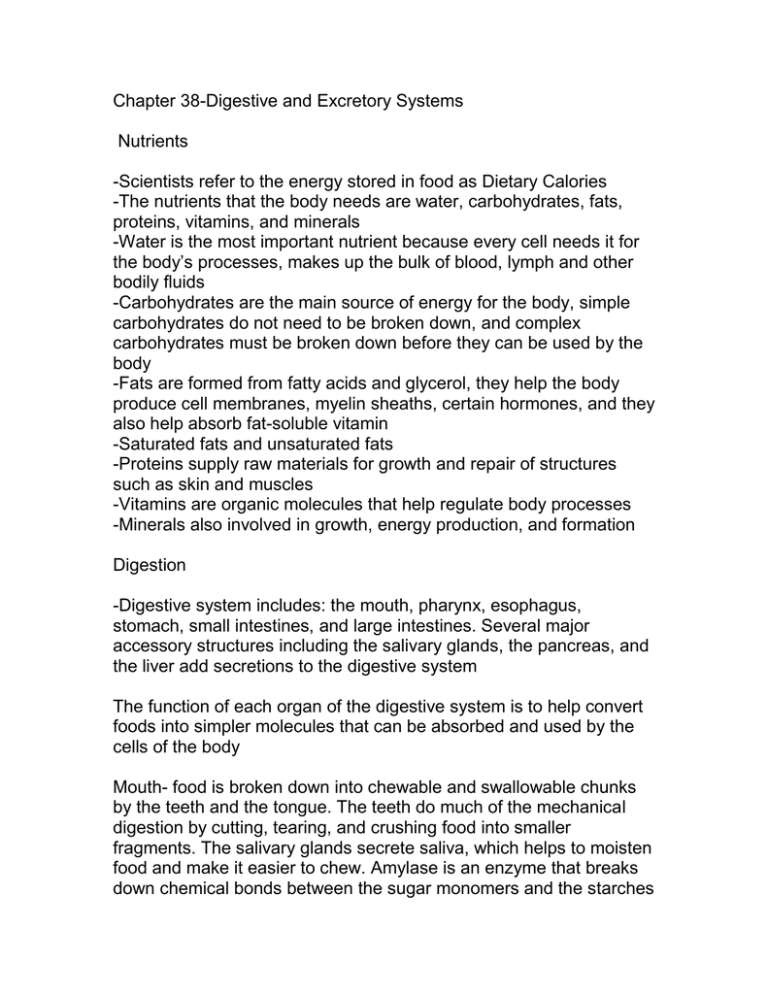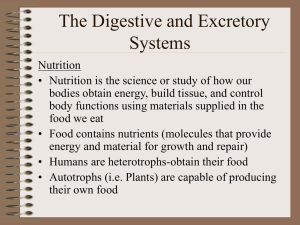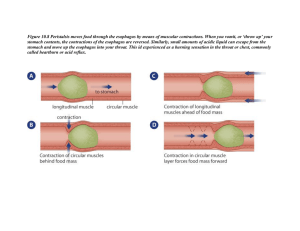Chapter 38-Digestive and Excretory Systems Nutrients
advertisement

Chapter 38-Digestive and Excretory Systems Nutrients -Scientists refer to the energy stored in food as Dietary Calories -The nutrients that the body needs are water, carbohydrates, fats, proteins, vitamins, and minerals -Water is the most important nutrient because every cell needs it for the body’s processes, makes up the bulk of blood, lymph and other bodily fluids -Carbohydrates are the main source of energy for the body, simple carbohydrates do not need to be broken down, and complex carbohydrates must be broken down before they can be used by the body -Fats are formed from fatty acids and glycerol, they help the body produce cell membranes, myelin sheaths, certain hormones, and they also help absorb fat-soluble vitamin -Saturated fats and unsaturated fats -Proteins supply raw materials for growth and repair of structures such as skin and muscles -Vitamins are organic molecules that help regulate body processes -Minerals also involved in growth, energy production, and formation Digestion -Digestive system includes: the mouth, pharynx, esophagus, stomach, small intestines, and large intestines. Several major accessory structures including the salivary glands, the pancreas, and the liver add secretions to the digestive system The function of each organ of the digestive system is to help convert foods into simpler molecules that can be absorbed and used by the cells of the body Mouth- food is broken down into chewable and swallowable chunks by the teeth and the tongue. The teeth do much of the mechanical digestion by cutting, tearing, and crushing food into smaller fragments. The salivary glands secrete saliva, which helps to moisten food and make it easier to chew. Amylase is an enzyme that breaks down chemical bonds between the sugar monomers and the starches Pharynx- the food then passes from the mouth or oral cavity into the pharynx. Once in the pharynx swallowing becomes involuntary. The medulla is the part of the brain that controls swallowing Esophagus- food is then passed through the food tube or esophagus and into the stomach. The food moves down the esophagus by involuntary muscle contractions known as peristalsis. The sphincter closes the esophagus after food passes into the stomach and prevents contents from moving back up. Stomach- Food enters the stomach from the esophagus. The stomach contains microscopic gastric glands that release mucus, hydrochloric acids, and gastric juices. Pepsin is also produced, especially useful for protein digestion. -Ulcers are lesions of the digestive tract lining -The semi-liquid mass of partially digested food known as chime enters the duodenum and into the small intestines. Pancreas-The presence of chime in the duodenum causes the release of pancreatic fluid from the pancreas. The pancreas is a gland formed by the duodenum and under the surface of the stomach. The pancreas produces hormones that regulate blood sugar levels, produces enzymes that break down carbohydrates, proteins, lipids, and nucleic acids, and also produces sodium bicarbonate. Liver-assists the pancreas, produces bile. Bile helps neutralize they chyme from the stomach and emulsifying fats. Bile is stored in the gall bladder. Small Intestine-made up by the duodenum, jejunum, and the ileum, specially adapted to absorb nutrients because it is covered with projections called villi. The Large Intestine-main job is to reabsorb water and electrolytes -Diarrhea occurs when there is interference with water absorption The Excretory System The skin, lungs, and kidneys along with their associated organs make up the excretory system. The Kidneys- The main organ of the excretory system are the two kidneys, which are located on either side of the spinal column near the lower back. A tube called the ureter leaves each kidney, carrying urine to the urinary bladder. The urinary bladder stores urine before being excreted. As blood travels through the kidney, urea, excess water, and other waste products are removed and collected as urine. Structure of the KidneysNephron-structural and functional unit of the kidney which manufactures urine Glomerulus-network of capillaries which constitutes part of a single nephron Bowmans capsule-double walled chamber which surrounds the glomerulus Proximal tubule-segment of the nephron tubule where water, sodium ions, glucose, and amino acids are absorbed into the wall Loop of Henle- the proximal tubule leads into the loop of henle where sodium ions are actively transported outs of the segment Distal tubule-additional sodium can be reabsorbed out by the distal tubule. Water is also reabsorbed here. Collecting tubule-receives urine form smaller tubules. Urine flows to the outside from the bladder through a tube called the urethra The kidneys play an important role in maintaining homeostasis. They regulate the water content of the blood and, therefore, blood volume, maintain blood pH, and remove waste products from the blood. Humans can survive with one kidney, but if both are damaged by disease or injury there are two ways to keep an individual alive. First is a kidney transplant from a healthy, compatible donor or second kidney dialysis.







